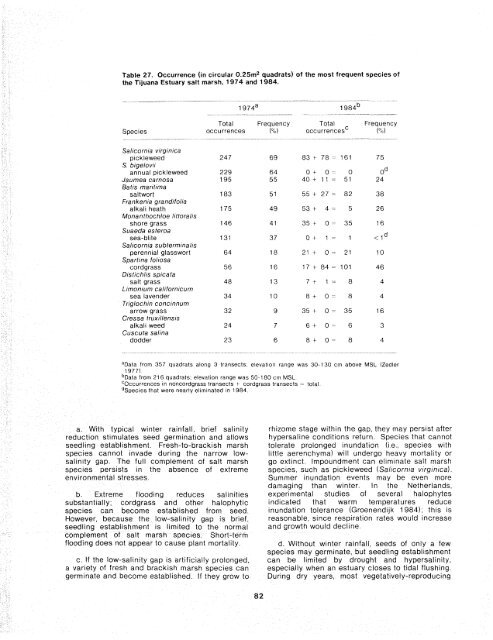The Ecology of Tijuana Estuary, California: An Estuarine Profile
The Ecology of Tijuana Estuary, California: An Estuarine Profile
The Ecology of Tijuana Estuary, California: An Estuarine Profile
Create successful ePaper yourself
Turn your PDF publications into a flip-book with our unique Google optimized e-Paper software.
Table 27. Occurrence (in circular 0.25m2 quadrats) <strong>of</strong> the most frequent species <strong>of</strong><br />
the <strong>Tijuana</strong> <strong>Estuary</strong> salt marsh, 1974 and 1984.<br />
Species<br />
Total Frequency Total Frequency<br />
occurrences t occurrencesC (ob<br />
Salrcornra v~rgrnrca<br />
pickleweed<br />
S brgelovrr<br />
annual p~ckleweed<br />
Jaumea carnosa<br />
Batrs mantrma<br />
saltwort<br />
Frankenla grand~folra<br />
alkali heath<br />
Monanthochloe Irttoralrs<br />
shore grass<br />
Suaeda esteroa<br />
sea-bllte<br />
Salrcornra subtermrnairs<br />
perennial glasswort<br />
Spartrna folrosa<br />
cordgrass<br />
Drstrchlrs sprcafa<br />
salt grass<br />
L~mon~um calrforn~cum<br />
sea lavender<br />
Trrgloch~n conclnnum<br />
arrow grass<br />
Cressa truxrllens~s<br />
alkali weed<br />
Cuscuta salrna<br />
dodder<br />
dData from 357 quadrats along 3 transects elevatcon range was 30-130 cm above MSL (Zedler<br />
1977)<br />
b~ata from 216 quadrats elevat~on range was 50-180 crn MSi<br />
COccurrences cn noncordgrass transects t cordgrass transects total<br />
"pec~es that were nearly eiim~nated in 1984<br />
a. With typical winter rainfall. brief sallnity<br />
reduction st~rnulates seed germination and allows<br />
seedling establishment Fresh-to-brackish marsh<br />
specles cannot invade during the narrow lowsalinity<br />
gap <strong>The</strong> fuli complement <strong>of</strong> salt marsh<br />
species persists rn the absence <strong>of</strong> extreme<br />
environmental stresses<br />
b. Extreme flooding reduces salinities<br />
substantially, cordgrass and other halophytic<br />
species can become established from seed<br />
However, because the low-salinity gap is brief,<br />
seedling establishment 1s limited to the normal<br />
complement <strong>of</strong> salt marsh species Short-term<br />
flooding does not appear to cause plant mortaiity.<br />
c If the low-salinity gap IS artificially prolonged,<br />
a var~ety <strong>of</strong> fresh and brackish marsh species can<br />
germinate and become established. if they grow to<br />
rhizome stage withln the gap, they may persist after<br />
hypersaline conditions return Specles that cannot<br />
tolerate prolonged inundation (I e , species with<br />
little aerenchyma) will undergo heavy mortality or<br />
go extinct Impoundment can eliminate salt marsh<br />
specles, such as pickleweed (Sal~cornra v~rglntca)<br />
Summer ~nundation events may be even more<br />
damaglng than winter In the Netherlands,<br />
experimental studtes <strong>of</strong> several halophytes<br />
indicated that warm temperatures reduce<br />
inundat~on tolerance (Groenendijk 1984)' thfs IS<br />
reasonable. since respiration rates would increase<br />
and growth would decline<br />
d. Without winter rainfail, seeds <strong>of</strong> only a few<br />
species may germinate, but seedllng establishment<br />
can be limited by drought and hypersalinity,<br />
especially when an estuary closes to tidal flushing.<br />
During dry years, most vegetat~vely-reproducing

















